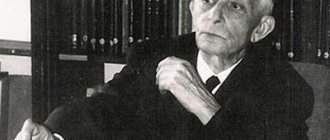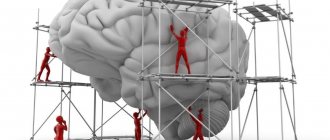- October 6, 2018
- Psychotherapy
- Michail Shattrie
Gestalt is an unfamiliar word to many, but the concept of Gestalt therapy has been known for decades. Most of the techniques that have appeared over the fifty years of its existence have formed the basis of modern psychotherapy. Among them are the “here and now” principle borrowed from Eastern philosophy, the holistic method according to which the world and man are an integral phenomenon, the principle of mutual exchange and self-regulation with the environment, the paradoxical theory of changes that occur with a person when he becomes who he is, not trying to play other roles; the same “empty chair” technique, when claims are expressed to an imaginary interlocutor, and not to a real one.
In simple terms, what is Gestalt therapy? We can say that it is a universal direction of psychotherapy that lays the foundation for working with the inner world - from childhood fears to coaching of top officials.
In psychology, Gestalt therapy involves the perception of a person as a single whole, combining the unconscious and conscious, past and future, mind and body, hatred and love. All this exists only at a specific moment in time, since the past no longer exists and the future has not yet arrived. A person is not able to exist in isolation, and the outside world is considered the environment in which our life is possible and which nourishes us. It is possible to receive what we need and give what overwhelms us only in contact with the outside world. When such mutual exchange is violated, a person’s life freezes and loses its meaning.
Gestalt therapy is aimed primarily at restoring relationships with the world, and not at recognizing mistakes and understanding why a person walks in circles.
Definition
As one of the areas of psychotherapy, the Gestalt method was formed in the middle of the last century. The theory of this therapy includes a number of practices, including traditional psychoanalysis, body-oriented therapy, Gestalt psychology, psychodrama and many other concepts. The term "gestalt" is of German origin - the word gestalt is translated as "shape, figure." The concept of gestalt, in simple terms, is a holistic image of a specific situation. From a scientific point of view, Gestalt is understood as a holistic structure located on the field of interaction between the environment and a person and covering the gap between the emergence of a need and its satisfaction. The founder of Gestalt therapy is considered to be the psychologist Friedrich Perls, who laid the foundation for the direction of psychology, according to which a person and his environment are a single whole.
Basic laws of Gestalt psychology
The Gestalt laws of perceptual organization are a set of principles for understanding some of the ways in which perception works. Here is a short description of each of them.
Transposition
The psyche responds to a complex of stimuli, and not to each one separately.
Constancy
All processes strive for immutability.
Proximity
The tendency to combine adjacent elements into one whole.
Figure and ground
Each figure is an isolated whole, the background is something dynamic behind the figure.
Law of Pregnancy
The tendency to react to the most constant and simple figure among all possible ones.
Closure
If a person sees something incomprehensible, the brain tries to transform the information into something that is familiar to us.
These laws are actively used in marketing and design to create images that will be perceived by our brain as “beautiful” and “correct”. When you take a closer look at these principles from a fine art perspective, you'll find that most well-known brands (from Amazon to Coca Cola) actively use them in their logos.
However, we will talk about this topic from a slightly different angle. What does all this have to do with the open gestalt with which we began the conversation? The most direct. You see, in addition to laws, in this direction of psychology there are also principles, such as:
- intimacy;
- similarity;
- integrity;
- adjacency;
- common area;
- isolation.
It is precisely the latter that encourages us to strive for completeness. This works both in relation to the visual objects that we see (if they are partially unfinished, the mind “completes” the missing elements), and in various situations in our life.
Do not miss
- Do not miss
It's time to eat: what was the experiment with Pavlov's dog, and how does it relate to our daily lives
An unfinished movie, an unfinished business in a romantic relationship, or unfulfilled dreams are all gestalts that need to be closed in order to find peace of mind.
Boundary and contact
Let's consider the basic concept of Gestalt therapy. Contact is the interaction of environmental capabilities and human needs. The latter can be satisfied only if a person comes into contact with the outside world:
- Food is required to satisfy hunger.
- Water is required to quench thirst.
- The need for communication is satisfied by contact with other living beings.
The contact boundary is the place where a person meets the outside world. In most cases, it is perceived as a line between the human body and what is located outside. However, such boundaries are not so precise and clear in all cases.
Basic concepts and process of therapy
The main approach of Gestalt therapy is called experimental-phenomenological: during Gestalt therapy, the client is asked to conduct experiments and observe the phenomena revealed during the experiments.
As an experiment, the client may be asked, for example, to talk about some event in his life, about some problem of his, to simply talk on an arbitrary topic, or to imagine and describe a certain hypothetical situation and how the patient would behave in it. Also, monodrama (also called the “empty chair method”) is often used as an experiment: the client is asked to imagine that some important person (or himself) is sitting on an empty chair next to him, and start talking to him (to himself) out loud . The therapist can intervene in the course of the experiment: guide it, ask questions, focus attention on something. The duration of the experiment is not set in advance. Before starting, the therapist instructs the client to carefully observe himself during the experiment and record the phenomena.
Phenomena may include: emotions, changes in voice (raising and lowering the tone, trembling, hesitating), facial expressions, posture, gestures, reaction time, the appearance of different sensations in the body (tension, heat, cold, “goosebumps”), etc. d. Only phenomena observed directly during an experiment are considered as phenomena, even if the experiment is devoted to past events. This reflects an important principle of Gestalt therapy - the principle of “here and now”, according to which work should be carried out only on feelings and thoughts present at the moment (including feelings and thoughts about past events), and not on those that were present at the moment past events.
By learning to record phenomena within oneself, the patient develops awareness, a key concept in Gestalt therapy. The success of Gestalt therapy as a whole depends on the success of developing this skill and teaching the patient to apply this skill in real life after the end of the therapy sessions.
After the experiment is completed, the phenomena are discussed with a Gestalt therapist. During the discussion, the topics of the client's needs and expectations are touched upon, and how these needs and expectations relate to what is actually happening, what other people need from the client, and how the expectations of the patient and other people relate. The Gestalt therapist points out phenomena that the client has missed that need to be paid attention to in future experiments to improve awareness. According to the canons of the humanistic approach in Gestalt therapy, the Gestalt therapist analyzes phenomena together with the client on equal terms, avoiding mentoring, trusting the client’s judgments, while being fully involved in the discussion process, revealing himself as a person, talking about his own experience and events in his life. For this reason, the personal qualities of the Gestalt therapist are of great importance in Gestalt therapy, more than in psychoanalysis and behavior therapy. A dialogue must be established between the client and the Gestalt therapist - another important concept of Gestalt therapy.
The goal of Gestalt therapy is to create and strengthen a holistic image (Gestalt) of the client’s personality. Through awareness, the client must identify the parts of his personality that he rejects: rejected emotions, needs, character traits, thoughts. Then accept (or neutralize) them, accept yourself and thereby restore the integrity of your personality. Much attention is also paid to the development of individual independence - the ability to follow one’s own dreams and needs, and not the needs of other people.
Alienation and identification
Both phenomena are characteristic of borders, where they arise. Identification implies classification into “one’s own” and “alien’’, where “one’s own” is understood as what is close and dear in any circumstances. Positive relationships - love, partnership, friendship - do not go beyond internal boundaries. The category of “strangers” includes negative relationships that are rejected by a person. Violation of boundaries provokes numerous problems that a person overcomes.
see also
- Gestalt psychology
- Existential psychology
- Phenomenology
- Psychodrama
- Play therapy
- Fairy tale therapy
- Process therapy
- gestalt psychology, gestalt,
- gestalt therapy,
- counseling on family problems, family problems, family systems theory M. Bowen, family diagram,
- family attitude,
Unfortunately, it is not easy to provide all the knowledge about Gestalt therapy in one article. But I tried. If you show interest in revealing the details, I will definitely write a sequel! I hope that now you understand what Gestalt therapy is, the Gestalt approach to counseling, family counseling, individual counseling, psychodrama and why all this is needed, and if you don’t understand, or have any comments, then don’t hesitate to write or ask in the comments, with pleasure I will answer. In order to gain a deeper understanding, I strongly recommend that you study all the information in the Individual and Family Counseling category.
Write answers to questions for self-test in the comments, we will check, or ask your own question on this topic.
When is Gestalt formed?
The life of any person is accompanied by a variety of gestalts of different scales - both small and large. Among them are relationships with parents, children and friends, quarrels with loved ones and close people, conversations with colleagues, feelings of falling in love, friendship. Gestalt arises spontaneously and not by the will of a person, but as a consequence of the emergence of a need that requires prompt satisfaction. It begins and ends, the latter at the moment the need is satisfied. Absolutely all a person’s desires cannot be fulfilled, and therefore the cycle of closing the gestalt may vary in duration.
Exercise “Feelings and Figure-Ground”
By allowing ourselves to “dip in” and feel a sensation, we become aware of the turning point where it peaks and then dissolves. And something else takes its place. If a certain feeling is blocked, it will not dissolve.
And it turns out that a person seems to feel it, but it is not in the present moment. It seems to be phonic, constantly reminding of itself. Consequently, until a person removes the block and closes the feeling, it will remind itself again and again.
This exercise is aimed at removing the blockage and closing the background feeling.
Take a comfortable position. Relax your body. Close eyes. Imagine your mother talking to you. Try to remember what she looks like, what she’s wearing, her pose. Stay with these memories for a while.
Photo by Fakurian Design on Unsplash
When you realize that you have a clear picture of her, tell her how you feel. Don't follow a logical sequence. List all your feelings one by one. Having said the next thing, take a short break: live a little with this feeling. What do you feel in your body when you describe love, warmth, guilt, resentment, etc.? Record and feel the transition from one feeling to another.
Deliberately change the speed of listing your feelings for your mother. Compare the sensations: are they different when you listen to yourself and when you give yourself the opportunity to feel what is said?
Do you notice any similarities between the unclear picture of the external world and your internal world? Have you noticed a change in your sense of excitement about what is happening when you force yourself to stop at each of the figures?
Gestalt cycle
An ideal cycle looks like this:
- Formation of need.
- Finding ways to implement it.
- Satisfying a need.
- Ending the contact.
The process can be complicated by various external or internal factors, which does not allow the cycle to be completed, since the contact boundary is broken.
The Gestalt remains in consciousness if the process is completely completed. An unclosed gestalt torments a person throughout his life, interfering with the satisfaction of other needs. Often it becomes the cause of malfunctions in the functioning of the protective mechanisms of the psyche.
Features of Gestaltherapy
Gestalt therapy is often called the “feminine approach” to problem solving. It is more suitable for sensitive women who like to delve into their own consciousness to find problems and the causes that gave rise to them, than for energetic, action-oriented men. Gestalt therapy implies that coping with internal problems is quite difficult and does not use positive images in its work. Gestalt sessions will not teach you how to live correctly, will not give you the basis for effective communication, and will not reveal the power of your mind. Here they will help you find existing problems and point out your mistakes and weaknesses. Having found an internal (necessarily relevant) problem, the therapist will help eliminate it so that it does not interfere with your development or normal life. Gestalt therapy will help you find a balance between your mind and feelings, with feelings taking center stage. You will be advised to pay more attention to signals coming from within and to adapt to the world creatively.
What defense mechanisms can fail?
Among these are the following:
- Introjection. Introducing the assessments, attitudes and motives of other people into a person’s inner world without a critical attitude towards them. Introjection plays a huge role in the development of a child’s psyche, as it allows him to become a personality. Pathological introjection comes from the perception of all habits, ideas and principles without combining them with accumulated life experience.
- Projection. The tendency to shift responsibility from a person to the world around him. People most often resort to projection when they cannot cope with their own negative emotions. Healthy relationships with other people are built through normal projection. Its pathological form can replace reality.
- Merger or confluence. A condition characterized by the absence of contact boundaries. In advanced cases, a person may lose awareness of himself. Temporary fusion is normally observed in mother and infant or lovers. Identification of the psyche of such people in most cases occurs in a short period of time. Pathological fusion is accompanied by over-control of other people.
- Retroflexion. The desire to do with yourself what you want to do with other people, or receive from them. Pathological retroflexion is often accompanied by psychosomatic illness and auto-aggression. In advanced cases, it can lead to human suicide.
The gestalt must be closed in all cases to avoid trouble. If this is impossible, then you should contact a specialist - a Gestalt therapist.
Is it possible to do the “Empty Chair” exercise at home?
Yes, but it will be more effective with a therapist. Firstly, because he will be able to look at the problem from the outside and, with the help of leading questions, will not let you get away from the topic. Secondly, if at some point your emotions reach a peak and you cannot calm down on your own, a specialist will help you do this. Thirdly, an unprepared person is unlikely to cope with psychological trauma on his own.
However, you can still try to free yourself from emotions. American family therapist Stuart Kaplowitz recommends Anger 101 Part III: The Empty Chair / GoodTherapy to his patients to do this exercise as needed to release negativity about someone or something. It won't make things worse if you speak out.
Stereo effect
In simple terms, what Gestalt therapy is, we can say that it primarily means contact therapy, which makes it unique. In psychotherapy, it is the only practice in which the specialist acts as himself, and does not take a neutral position as in classical psychoanalysis. The therapist has the right to his own desires and feelings, which he presents to the client during the session if necessary.
Who is a Gestalt therapist? This is a specialist to whom people come for help when they want to change something in themselves or their own lives. However, the therapist does not take on the role of someone who knows exactly what the client needs to do, and only facilitates the person’s meeting with his essence and inner “I”.
The therapist embodies part of the world with which the patient tries to build an ordinary relationship. During communication with the therapist, the client transfers to him his own stereotypes about people, norms of behavior and reactions to him, faced with the response of a specialist who does not adapt to the world of the person with whom he comes into contact. In most cases, such a reaction, characteristic of the Gestalt approach, causes bewilderment on the part of the client, since it does not fit into his usual scenario and forces him to go beyond expectations, fears, ideas and grievances. The patient begins to study his own reaction to an unexpected situation, new restrictions or opportunities. As a result, a person understands that he can maintain his own identity while maintaining intimate contact with other people. The freedom he lost to get out of the vicious circle or scenario returns again. The experience gained can be integrated by the individual into his life.
The main goal of the Gestalt approach in psychology is to return to a person his own boundaries, freedom of action and handling of life. The client in the therapeutic process is an equal participant and creator, and not an object of analysis. He is the one who knows where the way out of this situation is.
Working with Polarities
This method is often used by experienced Gestalt therapists. The main purpose of using this technique is to identify contradictions in a person’s personality, specific opposites. Working with polarities occupies a special place in this. If a person feels some uncertainty in himself, in his actions, then the therapist can offer to show himself to be more confident in a specific situation. If the client cannot directly ask for help, then in this case he turns to other group members for help. This therapy has a positive effect and allows you to develop your inner beliefs and awareness through working with polarities.
Whales of Gestalt therapy
Psychoanalysis of this type is built on several pillars:
- Awareness. Experience of oneself, sensory experience obtained as a result of contact. One of the moments when a person has an inner knowledge of who he is and what is happening to him. At a certain point in time, awareness, perceived as insight, becomes continuous. It entails responsibility as an understanding that a person chooses his own way of life. Initially, this causes resistance, since it deprives the benefit of the psychological game and demonstrates the whole underside of suffering and exploits. The reward after meeting our own “shadow” as a result of a therapy session is the understanding that the power over life and relationships with other people belongs only to us.
- The principle of reality. Accepting it is extremely difficult, unlike explaining it. A certain reality is formed on the basis of sensations, but at the same time a person’s opinion about it and its interpretation are formed. Such reactions are more varied than facts, and in most cases they are stronger than sensations. In conversations about what it is, Gestalt therapy is often called therapy of the obvious: when forming judgments, the specialist relies on what he hears and sees, and not on the client’s own generalizations and thoughts. The therapist tries to avoid interpretation and judgment, but asks the patient questions “how?” So what?". Long-term practice of using gestalts in psychotherapy has shown that in order for a person to understand a situation, it is enough to focus on the process, and not on its content. Meeting reality deprives the individual of all illusions, to which he reacts with resistance. Some group members admit that such experiences were true, but treacherous for them. Reality often forces you to admit reality and completely change your life, which is scary.
- Here and now. We all live in the present. The past is already over, the future has not yet arrived. Change is possible only here and now, like any other action. This principle of Gestalt therapy does not imply a denial of the past: the experience accumulated by the client remains with him and determines his behavior and reactions at a particular moment in time, including during a psychotherapy session. Despite this, here and now the patient communicates with the therapist on a specific topic, which provokes the question - why now and about this?
- Dialogue. The collision of two worlds - therapist and client - in Gestalt therapy. When they come into contact, one can explore the boundaries that arise between “not-me” and “me.” The patient for the first time (in most cases) has an experience formed as a result of interaction with someone who is not him, but retains his identity. The method is based on the I-You relationship in which I collide with feelings, You with other feelings and what happens between them and happens only at a specific moment in time, which will never be repeated. This experience is unique because the therapist is not a person in the client's life and does not need anything from him, while allowing the patient to be himself and without influencing his emotions and feelings.
If we talk about what Gestalt therapy is, it is a method of psychology, the main task of which is to discover the inner world of a person for himself. It does not carry educational goals and is designed to ensure that the individual minds his own business.
Exercise “Risk to be alive”
Being captive of one's own prohibitions, consisting of fantasies and dark thoughts, it is impossible to refute or confirm them until a person takes a risk and faces reality. When you come out into reality, as a rule, everything - what was so scary - turns out to be a soap bubble.
As F. Perls said, “Reality is nothing more than the sum of all awarenesses in the moment here and now”
Make a list of your desires that you want to realize, but for reasons of internal fears and concerns, you never decided to implement.
Highlight those desires that can be realized in the near future. Write down all the troubles that could happen if you start implementing your plans. Answer yourself these questions:
- Are the troubles on the list the ones that usually stop me from bringing my plans to life?
Giphy
- What consequences might there be for my attempts?
When the “sketch” of fears and troubles has been drawn up, take the risk of starting to realize what you want and check how many of the “catastrophic” troubles have come true.
If, nevertheless, something unpleasant happened, answer the question: were the consequences as destructive as initially expected, or was not everything as bad as it was pictured in the imagination? Was the game worth the candle? How do you feel now?
Let's look at this exercise with an example. Let's say you've wanted to learn to dance for a long time. But you were stopped by the thought that you were clumsy, not flexible, etc. The list of concerns may include the following:
- “I am clumsy and unplastic. People from the group will notice this and start laughing at me. I will feel ashamed, I will withdraw into myself and withdraw from the outside world. As a result, I will be left alone."
The key inhibitor in this case is the fear of loneliness.
The exercise helps to analyze concerns and leads to an awareness of what exactly is the inhibitory factor.
Goals of therapy
The main goal of Gestalt therapy is a person’s fuller awareness of himself. As a result of the sessions, the patient learns:
- Thoughts.
- Emotions.
- Body processes.
- Desires.
- Needs.
- Connections with the outside world.
- Relationship between people.
The result of gelstatt therapy is the patient’s ability to control his own behavior using certain aspects of his personality. People get rid of psychological and neurotic complexes, making their lives better.
Story
The basic ideas of Gestalt therapy were developed in the 1940s and 50s by Frederick (Fritz) Perls, his wife Laura Perls, and Paul Goodman. Fritz Perls, a psychoanalyst and convinced Freudian, at some point began to revise his views on psychoanalysis, and the first ideas of Gestalt therapy can be considered precisely as a revision of psychoanalysis. However, then his ideas underwent rapid development and quickly turned into an independent system of psychotherapy, incorporating elements of Gestalt psychology, existential psychology, psychodrama and other ideas popular in the 1940s.
Together with Paul Goodman and Ralph Hefferline in 1951, Perls wrote the seminal work Gestalt Therapy: Excitement and Growth in the Human Personality). In 1952, Perls moved to New York and, together with the “Seven” (besides him, the “Seven” included Laura Perls, Isidore Frome, Paul Goodman, Eliot Shapiro, Richard Kitzler and Paul Weiss) established the New York Gestalt Institute, whose headquarters were originally located in the Perls' apartment. The ideas of Gestalt therapy are quickly gaining popularity. In 1954, the Cleveland Institute of Gestalt Therapy was created, and by the late 50s, Gestalt therapy groups were organized throughout America. In the 60s, Gestalt therapy began to spread in Europe.
Compared to its early years, Gestalt therapy has undergone two important changes during its development. Firstly, group therapy, which was promoted by Fritz Perls, became less used, and at some stage he completely abandoned individual sessions, considering it an outdated technique. Secondly, the attitude towards the patient has become more tolerant and sympathetic. Entering into conflict with the patient, which Perls himself often used, began to be considered extremely undesirable, although in principle it remains acceptable within the framework of Gestalt therapy.
Application of therapy in practice
Gestalt therapy - what is it? This area of psychology refers to a certain psychotherapeutic methodology. Initially, specialists used techniques borrowed from various therapeutic practices. For example, the founder of therapy, Perls, resorted to the techniques of psychodrama - a method of group work that uses dramatic improvisation to understand the inner world and change it.
Today the list of techniques is huge and includes body and dance therapy, various subtypes of art therapy. Thanks to them, a holistic image is formed in the following areas of human life:
- Emotional. The area of experiences, feelings, the ability to express and understand them.
- Social. Relationships with other people, cultural environment and social relationships.
- Physical. Material well-being, physical and mental health, sexual maturity, aspects of material and physical life.
- Spiritual. Knowledge of spiritual values, oneself, life laws and the environment.
- Rational. Abilities for planning, analysis, creativity, thinking and foresight.
The concept of gestalt in psychology
Find out what awaits you today - Horoscope for today for all zodiac signs
Due to numerous requests from subscribers, we have prepared an accurate horoscope application for mobile phones. Forecasts will arrive for your zodiac sign every morning - it's impossible to miss! Download for free: Daily Horoscope 2020 (available on Android)
The word “gestalt” itself, translated from German, means form or image. This is something holistic and complete, with clear outlines and internal content. The founders of Gestalt psychology were German psychiatrists, but as a separate direction, Gestalt psychology has not survived to this day. But its place was taken by Gestalt therapy, the founder of which is considered to be the German psychiatrist Friedrich Perls.
Modern Gestalt therapy has its origins in scientific research of the 40s of the last century and is closely intertwined with the concept of cognitive behavioral therapy. Perls also does not hide the fact that he devoted many years to the study of Eastern spiritual practices, in particular Buddhism. It was Buddhism that became the starting point in the approach to getting rid of negative memories, because the Buddhist “theory of emptiness” can free any person from negative memories and the psychological clamps and blocks associated with them.
So, Gestalt is an image of the ideal situation towards which a human being strives. This is “the way it should be,” but it doesn’t always become that way. This is where stress and associated complexes and psycho-blocks originate. In psychotherapy there is a concept of “closing the gestalt.” This means bringing an unfinished situation to its logical conclusion, thereby getting rid of the negativity associated with it.
One example of gestalt is when a person cannot understand his feelings and does not know what he wants.
The human psyche perceives the situation in a holistic way: this is a feature of perception. If there is no complete image, the psyche “refines” it - fills in the details. This approach to seeing the world has been developed over centuries and millennia, and has helped man survive in wild environmental conditions. For example, if something spotted behind the bushes flashed, it was probably a leopard. If you suddenly smell something rotten, there is probably a stale animal corpse there. These are all gestalts - the creation of a complete picture and image from scraps and details.
Duration of courses
If we talk about what Gestalt therapy is in simple words, it is a medium-term method of psychotherapy. The course of treatment includes 10 meetings, one every week. Depending on the complexity of the patient’s problems, he may be prescribed a course of 30 meetings. The duration of therapy depends on the tasks assigned to the specialist, the existing problem and some other factors.
Theory
The creators of Gestalt therapy considered this direction of psychotherapy to be absolutely practical and not subject to theoretical study. Fritz Perls even had a concept called “elephant shit” to specifically refer to theorizing. However, over time, the volume of information and understanding of the experience of Gestalt therapy required theoretical systematization and analysis. Both were first taken up by Paul Goodman; it is to him that we owe the first construction of the contact cycle curve and the introduction of almost most of the definitions of modern Gestalt therapy. Initially, the theory of Gestalt therapy is based on one of the three contemporary areas of existential therapy, along with the existential analysis of L. Binswanger and logotherapy of W. Frankl. The basic idea of Gestalt is based on the ability of the psyche to self-regulate with the unity of all functions of the human body and psyche (as one of them) - holisticity , on the ability of the body to creatively adapt to the environment and on the principle of human responsibility for all of one’s actions, intentions and expectations. The main role of the therapist is to focus the client’s attention on awareness of what is happening “here and now” (and in the interpretation of F. Perls: “here and how”), limiting attempts to interpret events, drawing attention to feelings-indicators of needs, the client’s own responsibility for both the implementation and prohibitions on the implementation of needs.
Isidore Frome, Irvine and Mariam Polster (authors of “Integrated Gestalt Therapy: Contours of Theory and Practice”), Joseph Zinker, John Enright (author of the book “Gestalt Leading to Enlightenment”) also made great contributions to the development of the methodology and theory of Gestalt therapy. , Serge Ginger (author and co-author of twenty books on Gestalt) and others.
The self in the theory of Gestalt therapy is considered as a continuously ongoing process of interaction of the organism with the environment and with itself. There are three important functions in this process:
- Id is the totality of all bodily, affective and emotional processes;
- Personality - a set of processes of mnesis;
- Ego - function of choice, decision making, is activated only when there is a need to make a decision.
From the point of view of Serge Ginger, everything that happens to a person is an event that occurs at the contact boundary, that is, the contact boundary simultaneously ensures the isolation of a person from the environment and at the same time provides the possibility of interaction with the environment.
The approach to resistance in Gestalt therapy is fundamentally different from the approach of analytical directions. Gestalt considers resistances as ways of interaction of the organism with the environment, which once had high effectiveness for interaction, but here and now are either inappropriate or generally the only means of interaction available to the client (for example, for a drug addict client, the most characteristic way of interaction will be confluence of the second type, quite organic during the interaction between mother and baby). In this regard, the client’s resistance, naturally demonstrated by him during interaction with the therapist, is used as the basis for an effective search for the client’s unconscious needs.
Another function of Gestalt therapy is to make the client aware of his true needs. (For example, a young woman, the wife of a sailor, complains of being overweight. During therapy, it turns out that she gets very fat when her husband is sailing. A habit is also noted - at the beginning of the night she goes to the refrigerator and eats “to the fullest”, after which can sleep. As therapy progresses, the client becomes aware of the true bodily need—the need for sex—that is consumed by lonely nights. Accordingly, she gains awareness of what exactly she needs to solve the problem with.)
F. Perls developed Gestalt therapy, relying on the practice of psychoanalysis, existentialism, phenomenology, Eastern philosophy, field theory and the theory of Gestalt psychology. Conceptually, Gestalt therapy is inseparable from humanistic and existential psychology.
However, if you listen to Claudio Naranjo, you can learn about other origins and forms of Gestalt therapy. The main aspects of the traditional philosophy of Gestalt therapy are aspects of awareness, relevance and responsibility. The goal and means of traditional Gestalt therapy is “conscious awareness” (J. M. Robin, Enright, F. Perls, S. Ginger/Genger). The situation is experienced by the client here-and-now in the presence of consciousness. The degree of involvement of consciousness changes dynamically in connection with need, intensity of experiences, etc. K. Naranjo takes a different point of view, emphasizing relevance. One of the main techniques in Naranjo therapy is concentration on the present, here and now, which forms the basis of Naranjo Gestalt therapy. In order to highlight and distinguish this modality, Naranjo introduces his own term - presentation: “As in the case of dreams and fantasies about the future, Gestalt has its own approach to the past, which I proposed to call presentation (perception of the past from the point of view of the present ). Through enactment, the client again puts himself in the situation of which the memory haunts him, and manages it as if it were in the present.” There are at least two ways in which concentration on the present is reflected in the technical repertoire of Naranjo's Gestalt therapy. One is an explicit request to the client to follow his intentions: this expresses what comes out into his present field of consciousness. Most often this is accompanied by an admonition to refrain from thinking in the name of pure introspection. Another way is to present the past or future (or fantasy in general).
It should be noted that K. Naranjo’s approaches are not shared by all schools of Gestalt therapists.
Techniques
Gestalt therapy training today is carried out with an emphasis on groups. The specialist conducts classes as follows:
- "Hot chair" Chairs arranged in a circle are occupied by group members. In the center of the created figure there is a “hot chair”, on which any of the participants sits at their own request. He talks about all the problems that concern him. He must give frank and truthful answers to questions asked by other group members. It is important that the group has a warm and friendly atmosphere - it gives confidence and helps to relax.
- "Here and now". During the conversation, the problems that concern people at the moment are discussed. The past is not mentioned, and if one of the group members starts talking about it, the rest bring him back to reality. All actions must be performed tactfully and unnoticed by the participants.
- "Two roles." An empty chair is placed opposite the person sitting in the “hot chair”. The patient imagines that this chair is occupied by the person with whom he is in conflict, and simultaneously plays two roles, changing its location. He speaks on his own behalf while sitting on his chair, and on behalf of his “enemy” while sitting on the second chair. The method allows you to understand a person with whom the patient does not have a good relationship. The psychotherapist, as a rule, does not participate in such a conversation, monitoring its progress and drawing conclusions for himself. He intervenes in a situation only when it has a painful impact on the patient.
- "Feedback". A method that involves a constant psychological connection between the therapist and the patient. The specialist in such a situation plays the role of a mirror, reflecting the true face of his client. As a result, the patient looks at the situation differently, which helps him cope with his problems;
- "Action". The Gestalt therapist makes efforts to get his patient to act.
- “Now I realize.” An exercise that trains the patient’s activity and efforts aimed at analyzing his condition at a specific point in time. A person should regularly repeat the phrase “now I am aware.”
They talk about what it is - Gestalt therapy - in simple words during the training of psychotherapists, providing complete techniques and methods for its implementation.
Technique “Identification with external objects”
Allows you to identify hidden mental conflicts.
It happens that when a person is outraged by something or someone, as a rule, he talks about himself, and not about someone else.
Relax. Let go of your consciousness. Highlight everything you pay attention to. Maybe you're coming back to something? Focus on this. What does it represent? What are its main signs? Highlight the details. Now identify with it. Be like him. You are it.
What are you like now? What properties, traits, features do you have? Describe yourself. Say it out loud - I... What are you doing? What is your purpose? What exactly is your experience of identification with this object? Become aware of this experience.










